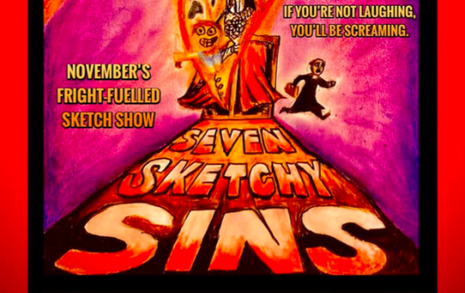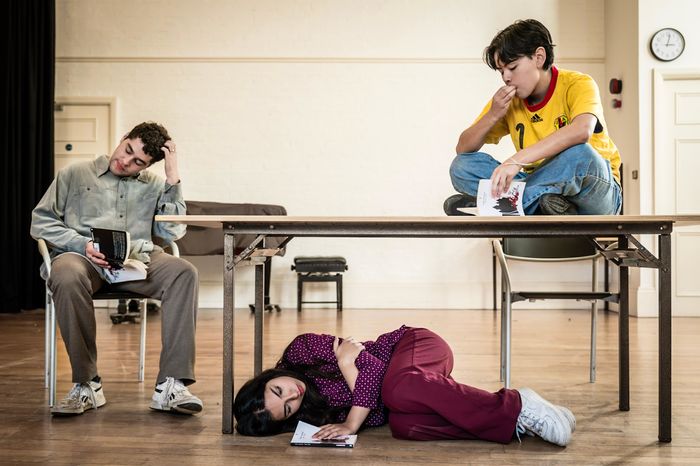Seven Sketchy Sins: Deadly funny but a little dull?
Bex Goodchild laughs yet lusts for a little more polish in this ADC sketch show

I knew this production was going to be interesting to review when I exited the theatre and one of my pages of notes consisted of the words “flesh”, “meta”, “dildo”. Seven Sketchy Sins was definitely an entertaining watch though some of the sketches were a lot stronger than others.
The show opened with a song from Margret Saunderson and Declan Boyd which captured the audience’s attention immediately. The song set the tone for the rest of the show, a seemingly self-aware sense of messiness and sarcasm. The dig at Drowsy Chaperone (the main show of the week) was particularly enjoyable. Saunderson and Boyd are joined by the rest of the cast towards the end of the song as they chant “Evil, evil, evil”. A couple of kazoos also find their way on stage as the cast throw all their energy into dancing along. Overall the energy was contagious and you couldn’t help smiling at the chaos occurring on stage. It definitely set the audience up for the sketches to follow while tying everything together in the sketch.
“The energy was contagious and you couldn’t help smiling”
However, it took my friend and I until sketch number 8 or 9 to realise that the title is in fact referring to the number of sins not to the number of sketches. If I’m being honest, I wish they had kept it to seven. Some of the sketches performed seemed significantly less thought out than others. A lot of them had potential but were drawn out and needlessly long as if they were trying to flesh out a scene for just one joke. I would have preferred to have a shorter, snappier sketch involving the one punchline, or it should have been cut all together. It didn’t help that there were some genuinely brilliant sketches that outshone the others. The sketch about a country watch presenter (played by Gabriel Owens) was definitely one of my favourites. Owens captures the presenter role, the likes of Matt Baker and John Craven, perfectly. He never breaks the calm and collected narration as he describes kidnapping someone for throwing a vape out a car window. The ‘victim’ (Kae Deller) is escorted on stage - screams muffled by a cloth tied over their mouth - and made to pay for their crime. ’Littering,’ Owen says, ’is the worst sin”.
Another stand out sketch was that of Blossom Durr and Grace Wakeman’s Piegella Foursome. Completely absurd and hilarious, we see Piegella (Blossom Durr) presenting her extremely sexual cooking show with her daughter Salmonella. As it turns out, the secret ingredient to her mince pie recipe is her daughter. The sketch ends with Piegella covered in blood as she finishes the show, while all we see of Salmonella is her legs sprawled out behind the table. The comedic timing as well as the carefully planned innuendos made for a very entertaining watch.
“It seemed some sketches turned to sex as a cheap laugh”
Many of the sketches used sexual innuendo - some to more intellectually stimulating ends than others. From finding dildos in the prop box to a long and honestly very graphic depiction of the relationship between captain hook and the tick tock croc, there is a lot to talk about. In a lot of cases it seemed some sketches turned to sex as a cheap laugh. Not to say this didn’t work, it definitely went down well with the audience. I do think there is something inherently funny about an ouija board spelling out “boner lol”. Yet, the sketches were at their best when they didn’t take themselves seriously and finding the laugh from the audience didn’t have to be complicated. One of the audience favourites seemed to be the ‘Sexorcist’ played by James Allen. You can probably work it out from the name but the character consisted of Allen dressed in a priest’s collar, a cross around his neck and rip-off trousers. This character appeared in two scenes and in both is stopped by the co-director, Helen Brookes for disgracing Cambridge theatre. It appeared to be a running theme to mock the seriousness of Cambridge theatre and the potential pretentiousness of comedy. The Sexorcist shows that theatre doesn’t necessarily need to be clever to be funny.
“Theatre doesn’t necessarily need to be clever to be funny”
I enjoyed the self-awareness and meta aspects of the show. Margaret Saunderson embodied the role of egotistical director and, contrary to the cast complaints in the sketch, had a huge stage presence that dominated the space even when she was alone on stage. Another character that stood out to me and the audience was that of Public Urination Man (Dom Andrew) whose monologues about his addiction to public urination seemed truly heartfelt. Again the silliness of the sketch really appealed to me.
The set and lighting, while extremely limited due to the nature of the show, was effective. Using different lighting states and spotlights, lighting designer Amelia Cordwell gave the blank stage depth and interest. The blue spot on Public Urination Man during his soliques, and the flashes of orange during the dragons den incinerations are examples of the technical work that made the whole show feel complete.
In all, there is definitely some room for improvement and much of the show seems somewhat unpolished, yet, ultimately, it was entertaining to watch. It didn’t take itself too seriously and I think that was the point. While I didn’t enjoy some sketches as much as others, it was still funny. Something relaxed and unserious which should really be what a sketch show is all about. Like Margret Saunderson so eloquently puts it in her sketch, “even the Gods make mistakes”.
 Comment / Plastic pubs: the problem with Cambridge alehouses 5 January 2026
Comment / Plastic pubs: the problem with Cambridge alehouses 5 January 2026 News / Cambridge businesses concerned infrastructure delays will hurt growth5 January 2026
News / Cambridge businesses concerned infrastructure delays will hurt growth5 January 2026 News / New movement ‘Cambridge is Chopped’ launched to fight against hate crime7 January 2026
News / New movement ‘Cambridge is Chopped’ launched to fight against hate crime7 January 2026 News / AstraZeneca sues for £32 million over faulty construction at Cambridge Campus31 December 2025
News / AstraZeneca sues for £32 million over faulty construction at Cambridge Campus31 December 2025 News / Uni-linked firms rank among Cambridgeshire’s largest7 January 2026
News / Uni-linked firms rank among Cambridgeshire’s largest7 January 2026









